-
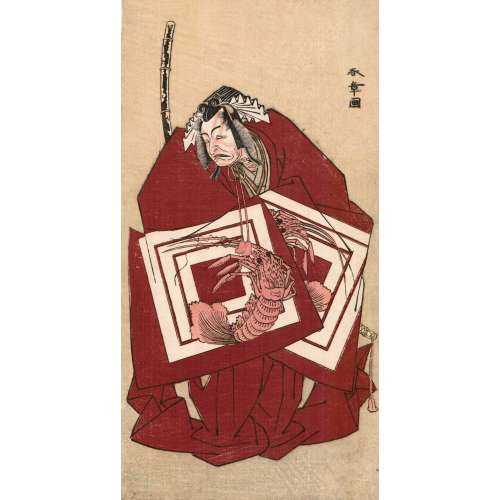 Ichikawa Ebizō III (Matsumoto Kōshirō II, Ichikawa Danjūrō IV, 1711-1778) probably shown as Shinozuka Gorō in the Shibaraku scene of the play Ōyoroi Ebidō Shinozuka, performed at the Nakamura Theater in the 11th month of 1772 (Meiwa 9). This was the occasion when he celebrated his name change, from Matsumoto Kōshirō II to Ichikawa Ebizō III. The lobster or giant shrimp (ebi) upon the Ichikawa family crest (three concentric squares - three measures of rice) on his garment underscores the fact of the name change (ebizō).
Ichikawa Ebizō III (Matsumoto Kōshirō II, Ichikawa Danjūrō IV, 1711-1778) probably shown as Shinozuka Gorō in the Shibaraku scene of the play Ōyoroi Ebidō Shinozuka, performed at the Nakamura Theater in the 11th month of 1772 (Meiwa 9). This was the occasion when he celebrated his name change, from Matsumoto Kōshirō II to Ichikawa Ebizō III. The lobster or giant shrimp (ebi) upon the Ichikawa family crest (three concentric squares - three measures of rice) on his garment underscores the fact of the name change (ebizō). -
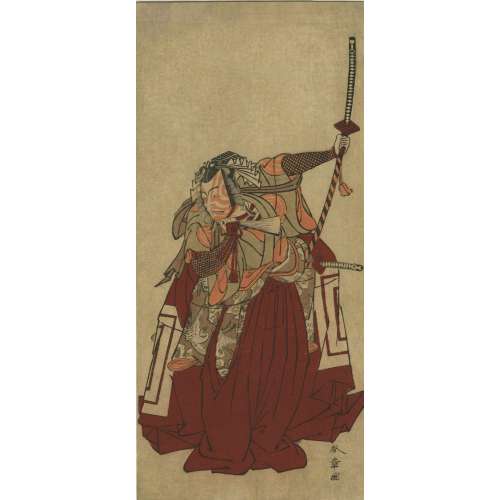 Katsukawa Shunshō ( 勝川 春章; 1726 – 19 January 1793).
Katsukawa Shunshō ( 勝川 春章; 1726 – 19 January 1793).SIZE: 12.5 x 5.75 in.
-
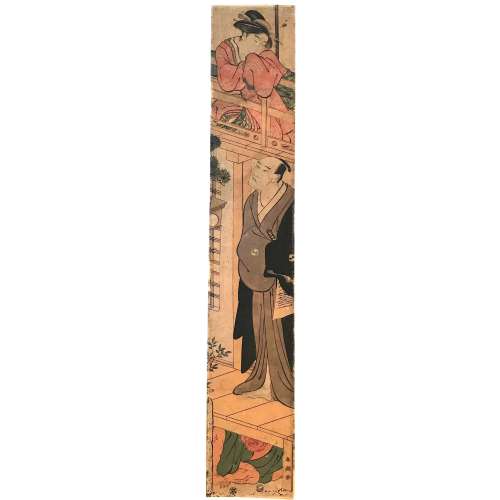 Katsukawa Shunshō ( 勝川 春章; 1726 – 19 January 1793).
Katsukawa Shunshō ( 勝川 春章; 1726 – 19 January 1793).Signed: Shunchô ga (春潮画); Censor's seal: kiwame (改印:極)
Publisher: Iwatoya Kisaburō (Eirindō); c. 1760s – 1832. Marks #173/p.169.
Reference: MFA ACCESSION NUMBER 11.21263. Not in Pins.
Act VII, Gion Ichiriki no ba ("The Ichiriki Teahouse at Gion") This act gives a taste of the bustling atmosphere of the Gion pleasure quarter in Kyoto. Yuranosuke is feigning a life of debauchery at the same teahouse to which Okaru has been indentured. Kudayū, the father of Sadakurō, arrives. He is now working for Moronō and his purpose is to discover whether Yuranosuke still plans revenge or not. He tests Yuranosuke's resolve by offering him food on the anniversary of their lord's death when he should be fasting. Yuranosuke is forced to accept. Yuranosuke's sword – the revered symbol of a samurai – is also found to be covered in rust. It would appear that Yuranosuke has no thoughts of revenge. But still unsure, Kudayū hides under the veranda. Now believing himself alone, Yuranosuke begins to read a secret letter scroll about preparations for the vendetta. On a higher balcony Okaru comes out to cool herself in the evening breeze and, noticing Yuranosuke close by, she also reads the letter reflected in her mirror. As Yuranosuke unrolls the scroll, Kudayū, too, examines the end which trails below the veranda. Suddenly, one of Okaru's hairpins drops to the floor and a shocked Yuranosuke quickly rolls up the scroll. Finding the end of the letter torn off, he realises that yet another person knows his secret and he must silence them both. Feigning merriment, he calls Okaru to come down and offers to buy out her contract. He goes off supposedly to fix the deal. Then Okaru's brother Heiemon enters and, hearing what has just happened, realises that Yuranosuke actually intends to keep her quiet by killing her. He persuades Okaru to let him kill her instead so as to save their honour and she agrees. Overhearing everything, Yuranosuke is now convinced of the pair's loyalty and stops them. He gives Okaru a sword and, guiding her hand, thrusts it through the floorboards to kill Kudayū. The main actor has to convey a wide variety of emotions between a fallen, drunkard rōnin and someone who in reality is quite different since he is only faking his weakness. This is called hara-gei or "belly acting", which means he has to perform from within to change characters. It is technically difficult to perform and takes a long time to learn, but once mastered the audience takes up on the actor's emotion. Emotions are also expressed through the colours of the costumes, a key element in kabuki. Gaudy and strong colours can convey foolish or joyful emotions, whereas severe or muted colours convey seriousness and focus. -
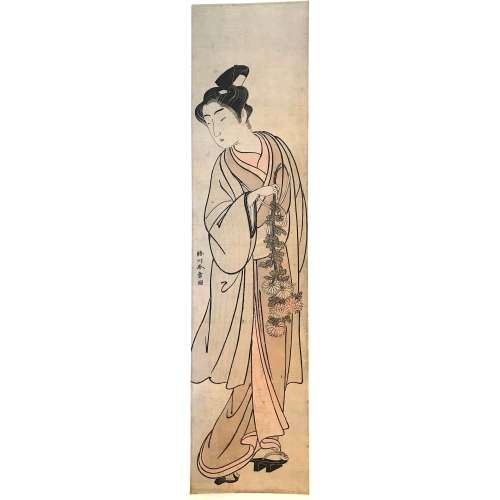 Katsukawa Shunshō ( 勝川 春章; 1726 – 19 January 1793).
Katsukawa Shunshō ( 勝川 春章; 1726 – 19 January 1793).Signed: Katsukawa Shunshô ga (勝川春章画).
The size is somewhat larger than the standard pillar print (hashira-e): 16.3 x 67.7 cm.
No references found so far.
-
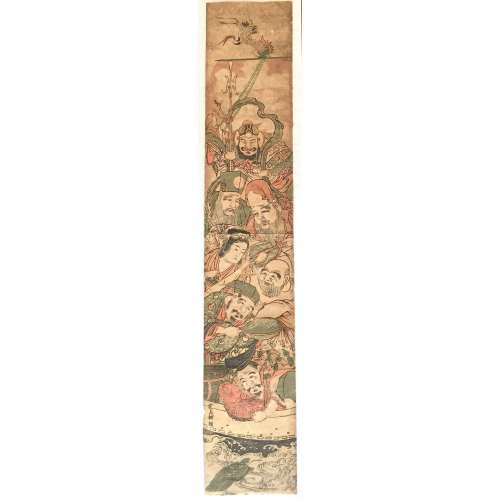 The Seven Gods of Good Luck in the Takarabune (ship of fortune) with a crane (the phoenix) above them.
The Seven Gods of Good Luck in the Takarabune (ship of fortune) with a crane (the phoenix) above them.Attributed to Katsukawa Shunshō, fl. 1726–92. Publisher: Uemura from Shiba (Edo). Marks "Publishers": U361|25-300: Uemura han (1793-1813). Marks "Artists, publishers...": Emiya Kichiemon (1688-1835). Artist signature absent. Looks very much like Pins #565 [p.223], but NOT the same. This exact design has not been found anywhere.

-

Iron tsuba of circular form with a branch of loquat (biwa) pierced in positive silhouette (ji-sukashi) and carved in marubori technique (marubori-sukashi). Kozuka and kogai hitsu-ana are plugged with shakudo.
Signature: Choshu Kawaji ju Hisatsugu saku. Chōshū school in Nagato province.
According to M. Sesko 'Genealogies' Hisatsugu was a 4th generation Kawaji School master from Chōshū (present day Nagato), with the name Gonbei, formerly Toramatsu, adopted son of Tomohisa (1687-1743) [page 117]. For Tomohisa work see TSU-0104 in this collection. -
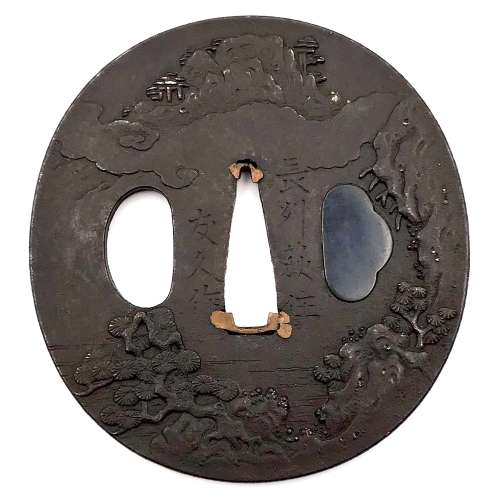
Iron tsuba of oval form carved with a landscape motif. Kogai-hitsu-ana plugged with shakudo. Sekigane of copper.
Signed: Chōshū Hagi-jū Tomohisa saku (長州萩住友久作).
Tomohisa, adopted son of Rokurō'emon, was 3rd generation master of Kawaji School from Hagi in Nagato (Chōshū), lived 1687-1743 [M. Sesko 'Genealogies', page 117].
Edo period, circa 1700. Dimensions: 71.1 x 66.8 x 2.9 mm For his adopted son Hisatsugu work see TSU-0103 in this collection. -
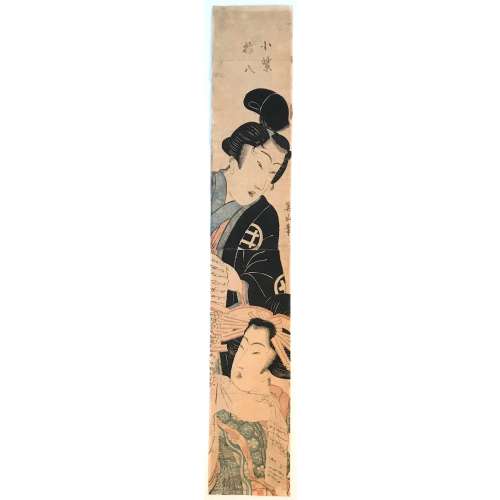 Kikukawa Eizan (菊川 英山, 1787 – July 17, 1867) Signed: Eizan hitsu (英山筆)
Kikukawa Eizan (菊川 英山, 1787 – July 17, 1867) Signed: Eizan hitsu (英山筆)Jacob Pins #972/p.341. Leiden, Rijksmuseum voor Volkenkunde.
"The Lovers Miura-ya Komurasaki and Shirai Gonpachi: Tragic love stories taken from real life and dramatized were a staple of stage and print; the darkly romantic combination of desire and death was hugely popular in the eighteenth century. Hirai Gompachi was a warrior of the Tottori fief in western Japan who fled to Edo after committing a murder. He was apprehended and sentenced to death in 1679. His distraught lover, the courtesan Komurasaki, committed suicide at his grave." [MET]
.
-
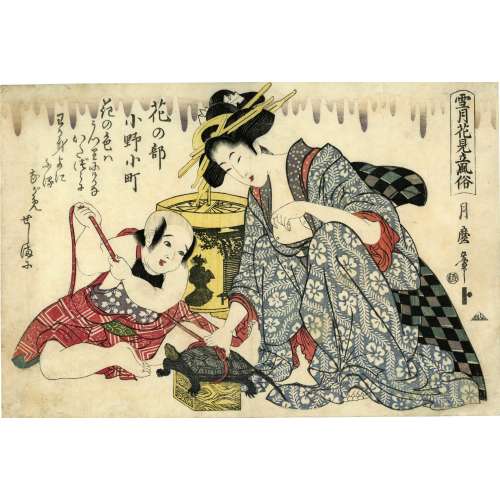
Kitagawa Tsukimaro (Kikumaro): 喜多川 月麿, fl. c. 1794–1836.
Mother is playing with her child: they left playing with shadow lantern for freeing a turtle (Hojo-e, or "Rite for the Release of Living Beings").Signed: Tsukimaro hitsu (月麿筆); Publisher's mark; censor's seal: Kiwame + Yamaguchiya Tôbei gyōji seal (1811-14).
-
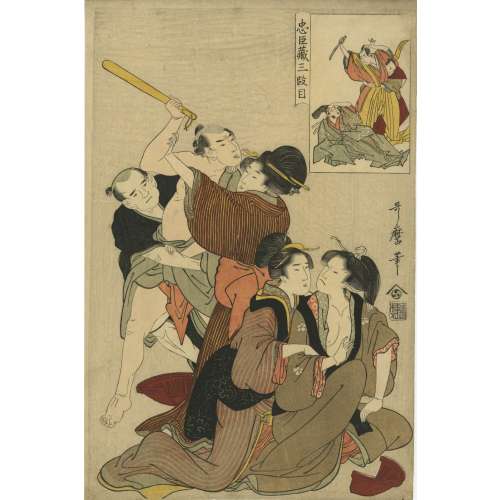 Kitagawa Utamaro (喜多川 歌麿; c. 1753 – 31 October 1806). Act III (Sandanme), from the series The Storehouse of Loyal Retainers (Chûshingura). Publisher Nishimuraya Yohachi (Eijudô). About 1801–02 (Kyôwa 1–2) Vertical ôban; 39.3 x 26 cm (15 1/2 x 10 1/4 in.). Reference: MFA ACCESSION NUMBER 11.14441 Ukiyo-e shûka 3 (1978), list #368.3; Shibui, Ukiyo-e zuten Utamaro (1964), 165.1.3; the series: Asano and Clark 1995, #s 383-5.
Kitagawa Utamaro (喜多川 歌麿; c. 1753 – 31 October 1806). Act III (Sandanme), from the series The Storehouse of Loyal Retainers (Chûshingura). Publisher Nishimuraya Yohachi (Eijudô). About 1801–02 (Kyôwa 1–2) Vertical ôban; 39.3 x 26 cm (15 1/2 x 10 1/4 in.). Reference: MFA ACCESSION NUMBER 11.14441 Ukiyo-e shûka 3 (1978), list #368.3; Shibui, Ukiyo-e zuten Utamaro (1964), 165.1.3; the series: Asano and Clark 1995, #s 383-5. -
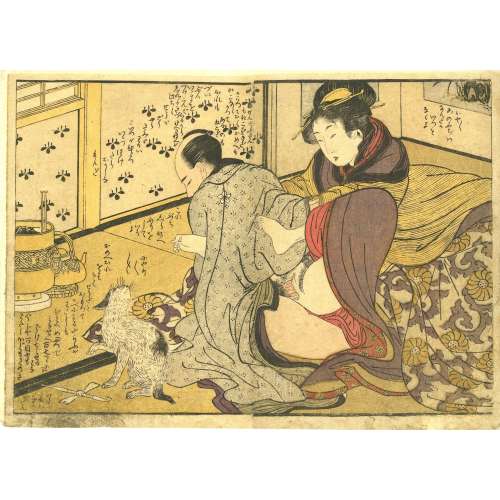 Kitagawa Utamaro. According to Chris Uhlenberg this is an illustration from the book Ehon koi no Onamaki, 3 vols, published in Kansei 11 (1799). Illustrated in b/w in: Hayashi Yoshikazu: Kitagawa Utamaro, in the series: Edo makura-e shi shusei, published in 1990, reissued 1994. Size: Chuban (25.5 x 18.5 cm), two book pages glued together.
Kitagawa Utamaro. According to Chris Uhlenberg this is an illustration from the book Ehon koi no Onamaki, 3 vols, published in Kansei 11 (1799). Illustrated in b/w in: Hayashi Yoshikazu: Kitagawa Utamaro, in the series: Edo makura-e shi shusei, published in 1990, reissued 1994. Size: Chuban (25.5 x 18.5 cm), two book pages glued together. -
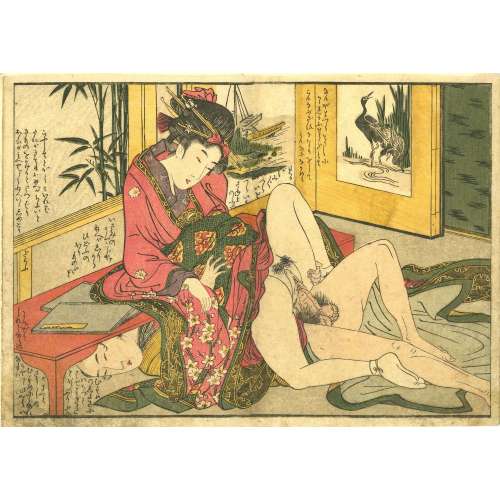 Kitagawa Utamaro. Illustration from book Ehon koi no Onamaki, published in 1799. Reference found by Chris Uhlenbeck: he found one of the designs in Hayashi Yoshikazu's 20-volume set Edo makura-e shi shusei: Kitagawa Utamaro. Size: Chuban (25.5 x 18.5 cm), two book pages glued together.
Kitagawa Utamaro. Illustration from book Ehon koi no Onamaki, published in 1799. Reference found by Chris Uhlenbeck: he found one of the designs in Hayashi Yoshikazu's 20-volume set Edo makura-e shi shusei: Kitagawa Utamaro. Size: Chuban (25.5 x 18.5 cm), two book pages glued together. -
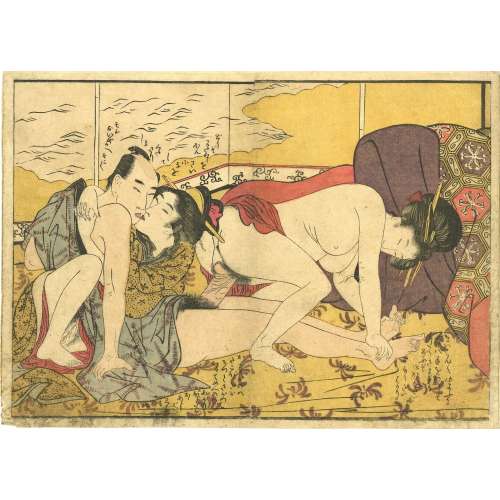 Kitagawa Utamaro. Illustration from the book Ehon koi no Onamaki. Cited at Hayashi Yoshikazu's 20-volume set Edo makura-e shi shusei: Kitagawa Utamaro. Size: Chuban (25.5 x 18.5 cm), two book pages glued together.
Kitagawa Utamaro. Illustration from the book Ehon koi no Onamaki. Cited at Hayashi Yoshikazu's 20-volume set Edo makura-e shi shusei: Kitagawa Utamaro. Size: Chuban (25.5 x 18.5 cm), two book pages glued together. -
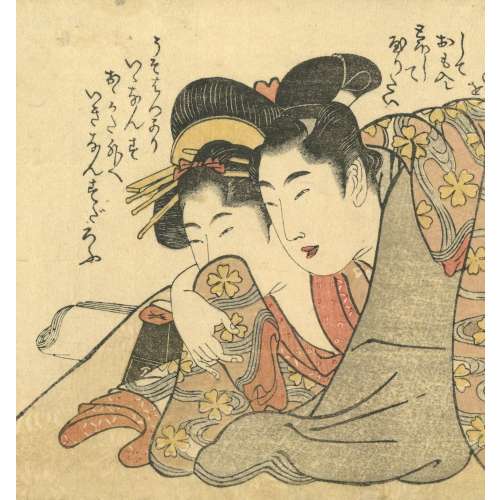 Artist: Kitagawa Utamaro [喜多川 歌麿] (Japanese, c. 1753 – 1806) "This uncommon half-size horizontal ōban ... is most likely one design from a set of twelve prints issued late in Utamaro's life" [Japanese Erotic Fantasies, Hotei Publishing, 2005, p. 143, pl. 47]. Half-size horizontal ōban must be 12.7 x 38 cm. Richard Waldman and Chris Uhlenbeck say it's tanzaku size (13 x 43 cm). In reality, the prints of this series measure 17 x 38 cm, which corresponds exactly to horizontal o-hosoban paper size. I managed to assemble 11 of allegedly 12 designs. 7 of them have genitals colored by hand. It's hard to tell whether it was done by the publisher on demand of a peculiar buyer, or by the owner of the prints who considered the black and white privy parts unnatural. My sequencing of the prints is arbitrary. Transcription of the text may help find the correct order.
Artist: Kitagawa Utamaro [喜多川 歌麿] (Japanese, c. 1753 – 1806) "This uncommon half-size horizontal ōban ... is most likely one design from a set of twelve prints issued late in Utamaro's life" [Japanese Erotic Fantasies, Hotei Publishing, 2005, p. 143, pl. 47]. Half-size horizontal ōban must be 12.7 x 38 cm. Richard Waldman and Chris Uhlenbeck say it's tanzaku size (13 x 43 cm). In reality, the prints of this series measure 17 x 38 cm, which corresponds exactly to horizontal o-hosoban paper size. I managed to assemble 11 of allegedly 12 designs. 7 of them have genitals colored by hand. It's hard to tell whether it was done by the publisher on demand of a peculiar buyer, or by the owner of the prints who considered the black and white privy parts unnatural. My sequencing of the prints is arbitrary. Transcription of the text may help find the correct order. As Japanese Erotic Fantasies put it: "a couple engaged in love-making, their stare fixed outside the picture plane". This is the only image of series that has a reference in available western literature, and the only one found in museum collections: Rijksmuseum Amsterdam (RP-P-1999-2001-16); reference: Fukuda (ed.) (1990), pls. 11-2.
As Japanese Erotic Fantasies put it: "a couple engaged in love-making, their stare fixed outside the picture plane". This is the only image of series that has a reference in available western literature, and the only one found in museum collections: Rijksmuseum Amsterdam (RP-P-1999-2001-16); reference: Fukuda (ed.) (1990), pls. 11-2.
 The scene of this print looks quite similar to that of the Kiyonaga's Sode no maki:
The scene of this print looks quite similar to that of the Kiyonaga's Sode no maki:
 The woman is "a young lady-in-waiting of Shogun's Court or Daimyō's Mansion, enjoying a rare outing from her tedious chores" [Richard Lane]. She is fully dressed in her outer cloak (shikake), white paper hat (agebōshi or tsunokakushi), and toed socks (tabi). A book or maybe, onkotogami (roll of tissues known as 'paper for honourable act' ) is still in the folds of her kimono. She is holding an open fan, either to cover her and her lover's faces from an unsolicited witness or to bring some fresh air to their joined lips. The pair just started their sexual intercourse.
The woman is "a young lady-in-waiting of Shogun's Court or Daimyō's Mansion, enjoying a rare outing from her tedious chores" [Richard Lane]. She is fully dressed in her outer cloak (shikake), white paper hat (agebōshi or tsunokakushi), and toed socks (tabi). A book or maybe, onkotogami (roll of tissues known as 'paper for honourable act' ) is still in the folds of her kimono. She is holding an open fan, either to cover her and her lover's faces from an unsolicited witness or to bring some fresh air to their joined lips. The pair just started their sexual intercourse.
 A scene from medieval times. A courtier in eboshi cap having sex with an aristocratic young woman with a long straight hairstyle (suihatsu).
A scene from medieval times. A courtier in eboshi cap having sex with an aristocratic young woman with a long straight hairstyle (suihatsu).
 Completely naked couple in the moment of ejaculation. Lavish garments with paulownia leaves on a yellow background counterbalance the white bodies on red bedding. The form of a woman's cheeks is telling, but I don't know about what. Maybe her advanced age?
Completely naked couple in the moment of ejaculation. Lavish garments with paulownia leaves on a yellow background counterbalance the white bodies on red bedding. The form of a woman's cheeks is telling, but I don't know about what. Maybe her advanced age?
 The pose of the couple and the overall composition are similar to that of the previous sheet. Though the lovers are dressed, and the woman's hairdo is well kept. The male looks older and the woman - younger.
The pose of the couple and the overall composition are similar to that of the previous sheet. Though the lovers are dressed, and the woman's hairdo is well kept. The male looks older and the woman - younger.
 A man takes a young maid from behind. She clenches the sleeve of her kimono in her teeth; it's either the moment of penetration (beginning of intercourse) or of her orgasm (the end of it).
A man takes a young maid from behind. She clenches the sleeve of her kimono in her teeth; it's either the moment of penetration (beginning of intercourse) or of her orgasm (the end of it).
 This seems to be a forced intercourse between a lackey with extensive bodily hair and a young maid from the same household.
This seems to be a forced intercourse between a lackey with extensive bodily hair and a young maid from the same household.
 This design is very much like the other one presented below, which is described at Japanese Erotic Fantasies on page 136 (pl. 43b) as follows: "The viewer peers through a mosquito net to see a child fast asleep, while his mother or wet-nurse moves towards her partner. On our print there is no child; instead of a sleeping baby, there is a roll of onkotogami. Fewer objects make the overall image concise, almost laconic in comparison with the Ehon hana fubuki (1802) design:
This design is very much like the other one presented below, which is described at Japanese Erotic Fantasies on page 136 (pl. 43b) as follows: "The viewer peers through a mosquito net to see a child fast asleep, while his mother or wet-nurse moves towards her partner. On our print there is no child; instead of a sleeping baby, there is a roll of onkotogami. Fewer objects make the overall image concise, almost laconic in comparison with the Ehon hana fubuki (1802) design:

 A young couple in a moment of true love. He is listening to the beating of her heart.
A young couple in a moment of true love. He is listening to the beating of her heart.
 This is a moment of true love between an old monk and a young samurai. The latter even did not take of his socks (tabi).
This is a moment of true love between an old monk and a young samurai. The latter even did not take of his socks (tabi).
 From Japanese Erotic Fantasies: "Boats played a crucial role in the workings of Yoshiwara, as they were the primary means of transport to the district. During the hot summer months, trips on pleasure boats were also a favourite pastime. Sex aboard a boat is a recurrent theme in shunga".
The last print that I am currently lacking and hunting for:
From Japanese Erotic Fantasies: "Boats played a crucial role in the workings of Yoshiwara, as they were the primary means of transport to the district. During the hot summer months, trips on pleasure boats were also a favourite pastime. Sex aboard a boat is a recurrent theme in shunga".
The last print that I am currently lacking and hunting for:
 I know where it is, but I cannot reach it... yet.
I know where it is, but I cannot reach it... yet. -
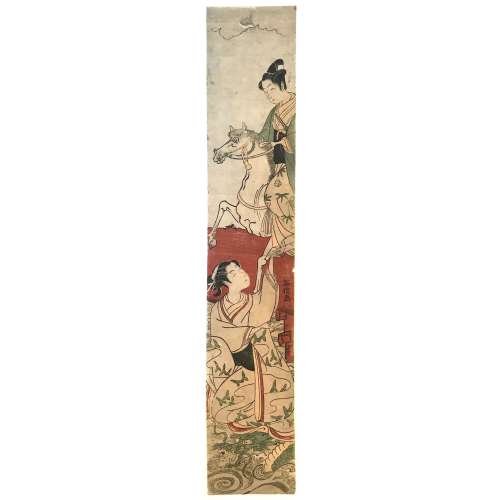 Santō Kyōden (山東 京伝, September 13, 1761 Edo – October 27, 1816) was a Japanese poet, writer and artist in the Edo period. He studied ukiyo-e under master Kitao Shigemasa (北尾 重政) [see SVJP-0006], and began illustrating kibyōshi under the pseudonym of Kitao Masanobu (北尾 政寅).
Santō Kyōden (山東 京伝, September 13, 1761 Edo – October 27, 1816) was a Japanese poet, writer and artist in the Edo period. He studied ukiyo-e under master Kitao Shigemasa (北尾 重政) [see SVJP-0006], and began illustrating kibyōshi under the pseudonym of Kitao Masanobu (北尾 政寅).Signed: Masunobu ga.
"Parody of the Nō Play Chōryō" (elsewhere) or "Parody of Huáng Shigōng and Zhāng Liáng" (David Waterhouse, The Harunobu Decade, Hotei Publishing, 2013, v. 2, №651). "The story [...] is about an encounter between the Chinese government minister Chôryô (Zhāng Liáng) and the legendary elder Kôsekikô (Huáng Shigōng) in the 3rd century BC. While riding a mule across a bridge, Kôsekikô dropped his sandal. Chôryô returned it to him. As a reward, Kôsekikô gave Chôryô a book of military strategy. Later, Chôryô helped to establish the Han Dynasty (207 BC-AD 220)." [The Walters Art Museum]References:
Waterhouse, The Harunobu Decade (2013), #651; Ukiyo-e shûka supp. 2 (1982), pl. 625; Pins, The Japanese Pillar Print (1982), #274/p.145; J. Kurth, Die Geschichte..., vol. II, Leipzig, 1928; S. Kikuchi, Ukiyo-e, 1966.
-
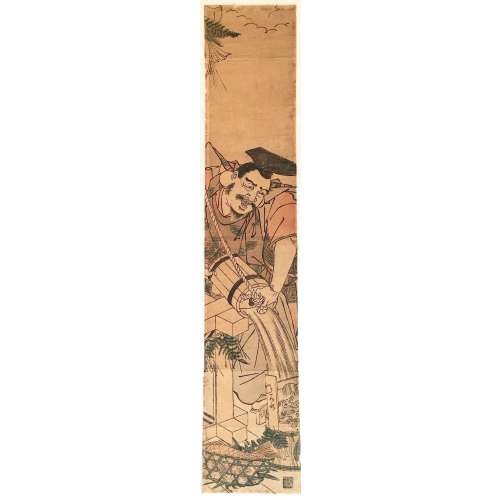 Ebisu drawing wakamizu, the first water drawn from a well on the New Year. Kitao Shigemasa (北尾 重政, 1739 – 8 March 1820). Signed: Shigemasa. Publisher's mark: Nishimuraya Yohachi.
Ebisu drawing wakamizu, the first water drawn from a well on the New Year. Kitao Shigemasa (北尾 重政, 1739 – 8 March 1820). Signed: Shigemasa. Publisher's mark: Nishimuraya Yohachi.References:
Jacob Pins #547 [p.217] - Ebisu drawing wakamizu, the first water drawn from a well on the New Year. TNM II (Tokyo National Museum Catalogue vol. 2) #1373.
-
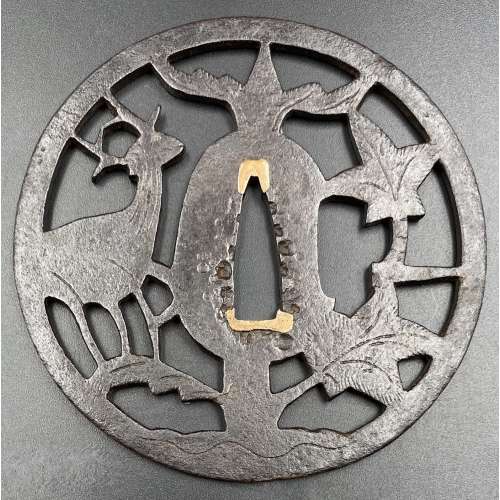
Iron tsuba of round form decorated with a deer and maple leaves in positive silhouette openwork (ji-sukashi), with details finely carved in low relief (kebori). Nakagō-ana plugged with copper fittings (sekigane). Traces of lacquer on the surface.
NBTHK: Hozon, №424947.
Design: An autumnal tsuba with an allusion to Kasuga Shrine in Nara.
Attributed by NBTHK to Shoami. Age: Probably the Momoyama period (1574 – 1603) or early Edo period (1603 – 1650), but judging on the item's substantial size (diameter 86.6 mm) and considerable thinness (3.4 mm) may be attributed to earlier times (late Muromachi period, 1514 – 1573). -
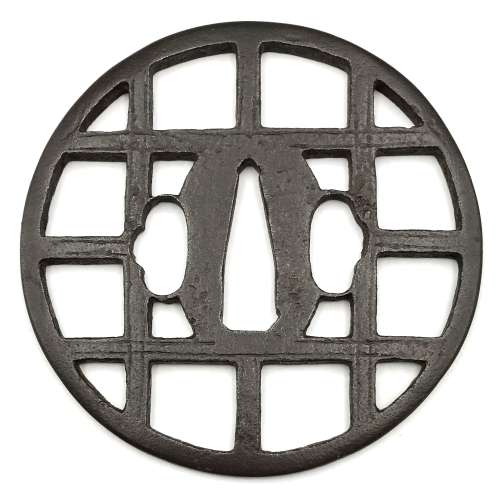 Iron tsuba of round form with design of lattice (kōshi-mon, 格子文) cut in openwork (sukashi), with low relief shallow linear carving along the bars. Well forged plate with brown-ish hue. To the right of nakago-ana there is a clear inscription of the character Shō (正), which is explained by Markus Sesko is follows: "The Shinsa obviously recognized more from the signature when having the tsuba in hand, i.e. they were confident to say it is signed "Shōami" but the rest is illegible (ika-fumei, 以下不明). That is, if they were just able to read the first character SHŌ (正) and saw that there were two more, most likely A (阿) and MI (弥), they would have put those character in boxes on the paper. Boxes around characters namely means that the character is not 100% legible but it can be assumed what it is." Momoyama or early Edo period. Dimensions: 85.9 mm diameter, 3.6 mm thickness at seppa-dai. Weight: 79 g. NBTHK certificate № 425069 with attestation: Hozon - "Worthy of preservation". A similar tsuba is presented at Japanese Sword Fittings from the R. B. Caldwell Collection. Sale LN4188 "HIGO". Sotheby's, 30th March 1994, №15. The description says: "A rare early Kamakura-bori tsuba. Nambokucho period (late 14th century). Of circular form, the dark plate carved and pierced with a gate design, the struts with double engraved lines. Unsigned. 8.5 cm." The lot was sold for 1,840 GBP.We have two possible explanations of the discrepancy between Sotheby's and Shinsa/Sesko attribution: 1) either Sotheby's or Shinsa/Sesko were wrong in their attribution or 2) these are two different pieces, one - Kamakura-bori from the 14th century and another - Shōami from 16th/17th century. Anyway, I would consider my piece as a Shōami tsuba of Momoyama - early Edo period, just for the sake of modesty.
Iron tsuba of round form with design of lattice (kōshi-mon, 格子文) cut in openwork (sukashi), with low relief shallow linear carving along the bars. Well forged plate with brown-ish hue. To the right of nakago-ana there is a clear inscription of the character Shō (正), which is explained by Markus Sesko is follows: "The Shinsa obviously recognized more from the signature when having the tsuba in hand, i.e. they were confident to say it is signed "Shōami" but the rest is illegible (ika-fumei, 以下不明). That is, if they were just able to read the first character SHŌ (正) and saw that there were two more, most likely A (阿) and MI (弥), they would have put those character in boxes on the paper. Boxes around characters namely means that the character is not 100% legible but it can be assumed what it is." Momoyama or early Edo period. Dimensions: 85.9 mm diameter, 3.6 mm thickness at seppa-dai. Weight: 79 g. NBTHK certificate № 425069 with attestation: Hozon - "Worthy of preservation". A similar tsuba is presented at Japanese Sword Fittings from the R. B. Caldwell Collection. Sale LN4188 "HIGO". Sotheby's, 30th March 1994, №15. The description says: "A rare early Kamakura-bori tsuba. Nambokucho period (late 14th century). Of circular form, the dark plate carved and pierced with a gate design, the struts with double engraved lines. Unsigned. 8.5 cm." The lot was sold for 1,840 GBP.We have two possible explanations of the discrepancy between Sotheby's and Shinsa/Sesko attribution: 1) either Sotheby's or Shinsa/Sesko were wrong in their attribution or 2) these are two different pieces, one - Kamakura-bori from the 14th century and another - Shōami from 16th/17th century. Anyway, I would consider my piece as a Shōami tsuba of Momoyama - early Edo period, just for the sake of modesty.
Caldwell Collection. Sotheby's 1994, №15.
-
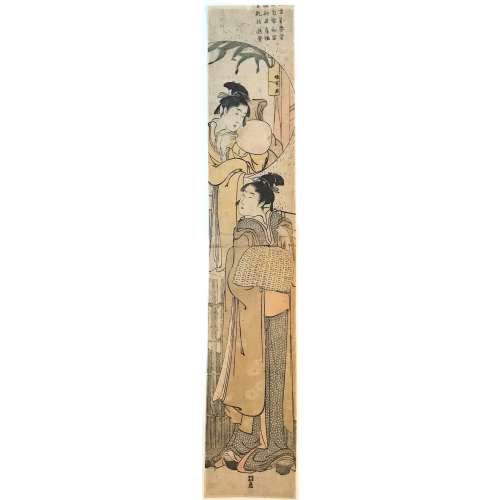 Woman Looking out a Round Window at a Woman with a Komusō Hat.
Woman Looking out a Round Window at a Woman with a Komusō Hat.Artist Koikawa Harumasa (a.k.a. Banki): fl. 1801–18. Wikipedia: Koikawa Harumasa (恋川 春政; active 1800–1820), later called Banki Harumasa (晩器 春政). Associated with Katsukawa school.
Signed: Banki ga (on the bamboo flower container in the background). Censor's seal: kiwame. Mark of unidentified publisher, Genshoku #1017; Marks U084 Ibiko, p. 387.
References:
Jacob Pins #828.
-
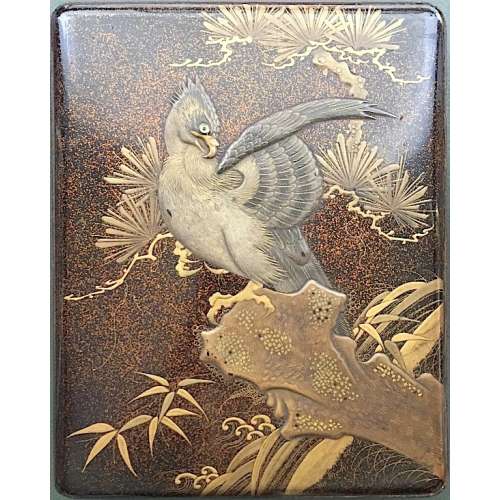 Japanese lacquer writing box (suzuribako) with an eagle sitting on a pine tree over the see waves. Rectangular box with rounded corners, slightly convex overlapping lid. Lacquer on wood with maki-e decoration in gold powder. The lid decorated inside with pine cones and needles over gold maki-e. Edo or Meiji period, 19th century.
Japanese lacquer writing box (suzuribako) with an eagle sitting on a pine tree over the see waves. Rectangular box with rounded corners, slightly convex overlapping lid. Lacquer on wood with maki-e decoration in gold powder. The lid decorated inside with pine cones and needles over gold maki-e. Edo or Meiji period, 19th century. -
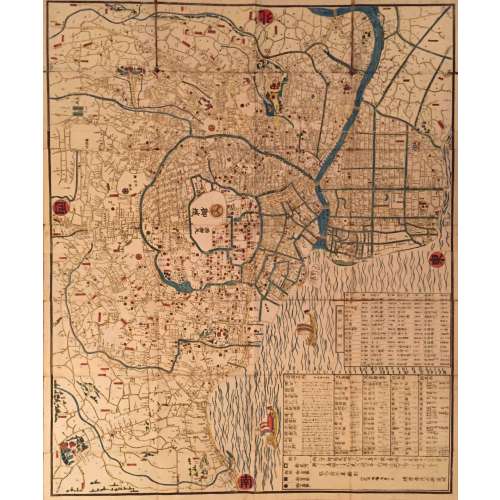
-
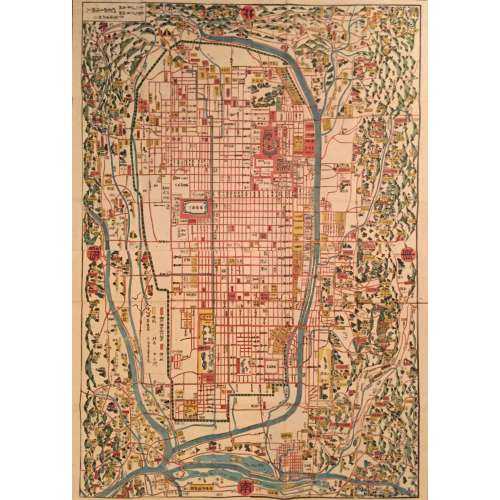
-
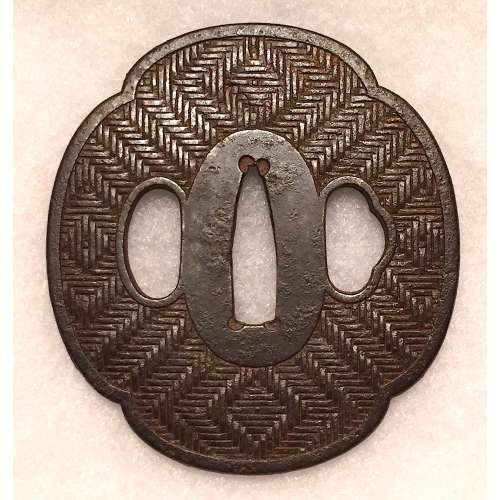 Iron tsuba with brown patina in mokkō-gata form with woven design. Size: 72 x 67 x 5 mm.
Iron tsuba with brown patina in mokkō-gata form with woven design. Size: 72 x 67 x 5 mm. -
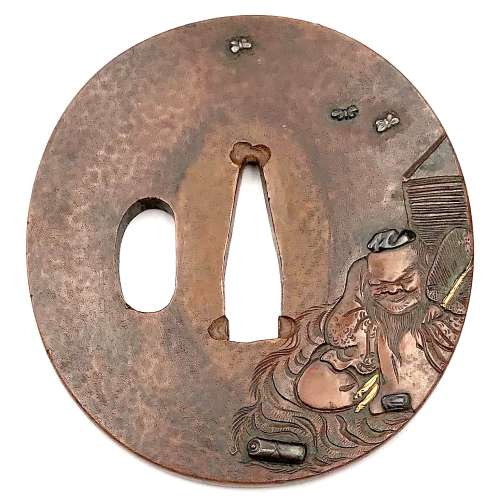
Copper tsuba of slightly elongated round form carved in low relief (shishiaibori and sukisagebori) and inlaid in gold, silver and shakudō with the design of dreaming Rosei (Lu Sheng): he is half-sitting by the pillow with his eyes closed, holding his fan, with a scroll by his feet, surrounded by flying butterflies.
Edo period, first half of the 18th century.
Dimensions: 70.8 x 67.1 x 5.0 mm. Signed on the reverse: Jōi (乗 意) + Kaō. Sugiura Jōi [杉 浦 乗 意] (1701-1761) was a master of Nara School in Edo; he was a student of Toshinaga [M. Sesko, ‘Genealogies’, p. 32]. “Sugiura Jōi (1701-1761) made many fuchigashira and kozuka, tsuba are rather rare.” [M. Sesko, The Japanese toso-kinko Schools, pp. 148-149]. On Rosei (Lu Sheng) dream's legend see Legend in Japanese Art by Henri L. Joly (1908 edition) on page 293. -
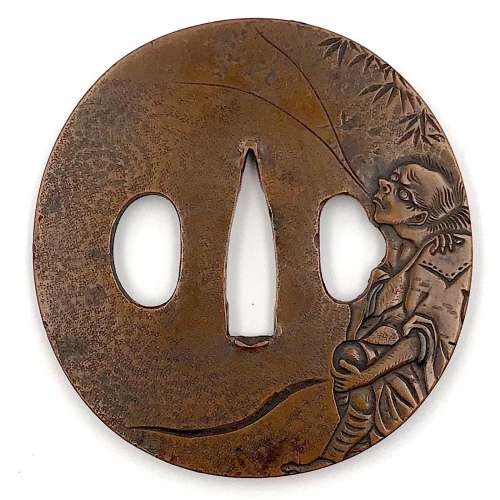
Copper tsuba of oval form carved in kebori and katakiribori with Tekkai Sennin sitting under bamboo on the face and with a pine tree on the back. Ishime-ji treated surface.
Signed on the reverse: Jōi (乗 意).
Edo period (First half of 18th century). Dimensions: 69.6 x 66.5 x 4.5 mm Sugiura Jōi (杉 浦 乗 意) was a master of Nara School in Edo; he was a student of Toshinaga [M. Sesko, 'Genealogies', p. 32]. "Sugiura Jōi (1701-1761) made many fuchigashira and kozuka, tsuba are rather rare." [M. Sesko, The Japanese toso-kinko Schools]. -
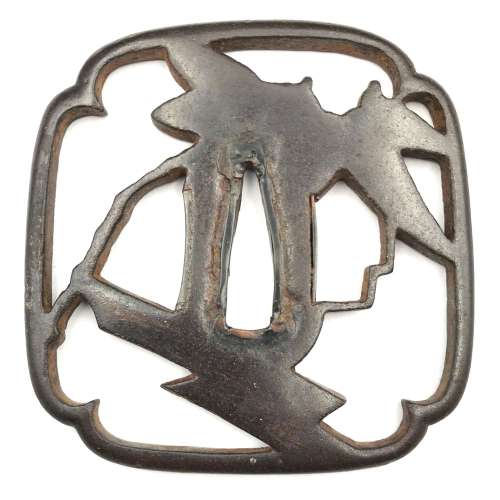 Iron tsuba of quatrefoil form with design of bamboo stems and leaves, and a plank bridge in openwork (sukashi). Hitsu-ana of irregular form. Iron with smooth chocolate patina. Copper and shakudō sekigane. This piece is illustrated in Sasano: Japanese Sword Guard Masterpieces from the Sasano Collection, 1994 on page 295 under № 254 with the following description:
Iron tsuba of quatrefoil form with design of bamboo stems and leaves, and a plank bridge in openwork (sukashi). Hitsu-ana of irregular form. Iron with smooth chocolate patina. Copper and shakudō sekigane. This piece is illustrated in Sasano: Japanese Sword Guard Masterpieces from the Sasano Collection, 1994 on page 295 under № 254 with the following description:Nishigaki. First generation Kanshiro (died in the sixth year of Genroku, 1693, at the age of 81). Sukashi design: Bamboo (take). Early Edo period, late 17th century (Kanbun / Enppo era). Height: 72.6 mm; Width: 71.5 mm; Rim thickness: .6 mm; Centre thickness: 5.1 mm. Rounded rim. The shape of this sword guard is a quatrefoil and the design is arranged in the form of a saddle flap. Two bamboo trunks with leaves comprise the design. Calm, soothing and sophisticated are the features of this artist in his later years. Such characteristics may remind one of the work of the first Hikozo.
Provenance: Sasano Masayuki collection, № 254. What is interesting, and what had been found by Bruce Kirkpatrick, is that in the earlier photograph of the same piece ['Sukashi tsuba - bushido no bi' by Sasano Masayuki, photography by Fujimoto Shihara, 1972 (in Japanese), page 245, №201] we clearly see kebori - linear carving that decorates the bamboo leaves and the planks of the bridge. The said kebori have totally disappeared between 1972 and 1994. The tsuba became absolutely flat! Now we can only speculate about the reasons for such cruel treatment of the artistically and historically important item.
Sukashi tsuba - bushido no bi. Author: Sasano Masayuki, photography: Fujimoto Shihara, 1972 (in Japanese). Page 245, №201.
-
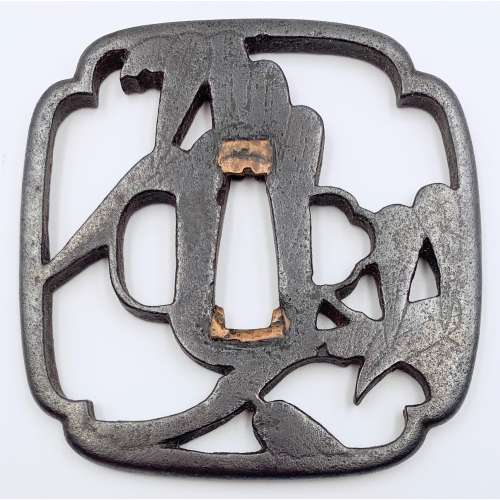 Iron tsuba of quatrefoil form with design of bamboo stems and leaves in openwork (sukashi) decorated with carving (kebori) . Copper sekigane. Early Edo period, late 17th century (Kanbun / Enppo era). First generation Kanshiro of Nishigaki school in Higo Province died in the sixth year of Genroku, 1693, at the age of 81). Height: 74.4 mm; Width: 74.2 mm; Centre thickness: 4.9 mm. Rounded rim. The design was quite popular among the Higo masters.
Iron tsuba of quatrefoil form with design of bamboo stems and leaves in openwork (sukashi) decorated with carving (kebori) . Copper sekigane. Early Edo period, late 17th century (Kanbun / Enppo era). First generation Kanshiro of Nishigaki school in Higo Province died in the sixth year of Genroku, 1693, at the age of 81). Height: 74.4 mm; Width: 74.2 mm; Centre thickness: 4.9 mm. Rounded rim. The design was quite popular among the Higo masters.
Kanshiro III, early 18th century (Sasano 1994 №267)

Matashichi I, late 17th century (Sasano 1994 №270)
The design of my tsuba closely resembles the one at the last example (Sasano 1994 №280), however, the form (mine is quatrefoil) and the execution (strength) are very different, which result in a very different spirit of my piece.
Shigemitsu II, early 18th century (Sasano 1994 №280)
-
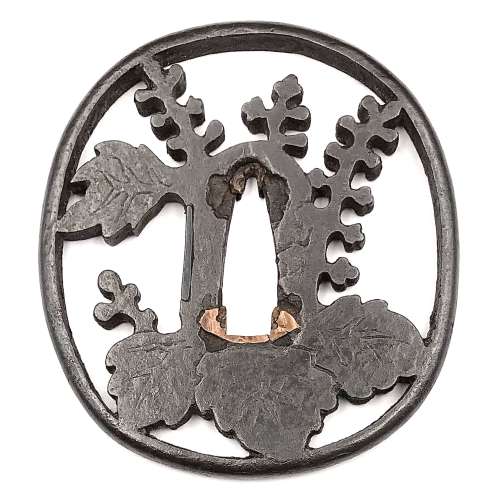 Iron tsuba of oval form with design of stylized paulownia (nage-giri) in openwork (sukashi). Leaf veins carved in kebori technique. Rounded rim. Copper sekigane. Unsigned. Attributed to Kanshirō, third generation Nishigaki (1680-1761). Edo period: Early 18th century (Kyoho / Genbun era). Size: Height: 77.8 mm. Width: 71.9 mm. Rim thickness: 5.9 mm. Center thickness: 5.0 mm. Provenance: Sasano Masayuki Collection, № 264: "Nishigaki. Third generation Kanshiro (died in in the eleventh year of Hohreki, 1761 at the age of eighty-two). This oblong shape appears a little amateurish at first, however, it was done intentionally to add flavor to to the design. The neat composition is a feature of the third Kanshiro."
Iron tsuba of oval form with design of stylized paulownia (nage-giri) in openwork (sukashi). Leaf veins carved in kebori technique. Rounded rim. Copper sekigane. Unsigned. Attributed to Kanshirō, third generation Nishigaki (1680-1761). Edo period: Early 18th century (Kyoho / Genbun era). Size: Height: 77.8 mm. Width: 71.9 mm. Rim thickness: 5.9 mm. Center thickness: 5.0 mm. Provenance: Sasano Masayuki Collection, № 264: "Nishigaki. Third generation Kanshiro (died in in the eleventh year of Hohreki, 1761 at the age of eighty-two). This oblong shape appears a little amateurish at first, however, it was done intentionally to add flavor to to the design. The neat composition is a feature of the third Kanshiro." -
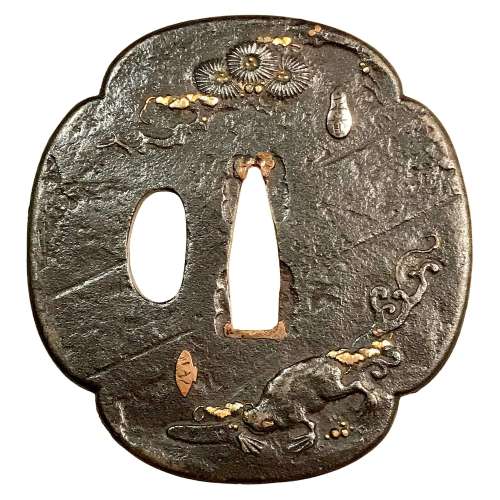
Iron tsuba of mokkō-form with a pine and a frog on the face and a snail on the back, carved and inlaid with gold. Each figurative element of the design is signed on three inlaid cartouches: Masaharu (正春), Kazuyuki (一之), and Yoshikazu (良一) [read by Markus Sesko]. Snake, snail, and frog together make a design called "SANSUKUMI" - Three Cringing Ones [Merrily Baird]. The snail can poison the snake, the frog eats the snail, and the snake eats the frog. It's unclear whether the pine replaces the snake on this tsuba, or the snake is hiding in the pine? Anyway, the frog and the snail are clearly represented. "Maybe we have here a joint work with Masaharu (the silver cartouche next to the pine) being the master and making the plate and Kazuyuki and Yoshikazu as his students carving out the frog and the snail respectively". Copper sekigane.
Dimensions: 70.9 x 67.2 x 3.0 mm. Edo period (18th century).Markus Sesko writes: "I agree, the frog and the snail most likely allude to the san-sukumi motif. It is possible that we have here an artist's choice to deliberately leave out the snake, maybe he thought that the motif is already obvious and there is no need to add a snake to make it clear that the tsuba shows the san-sukumi motif." [Markus Sesko].
Kazuyuki (一之): adopted son of Kumagai Yoshiyuki, student of Ichijō (Gotō-Ichijō Scool) [M. Sesko 'Genealogies', page 19.] Masaharu (正春): Kasuya fam., student of Masamichi (1707-1757) who was the 4th generation Nomura School master in Edo. [M. Sesko 'Genealogies', page 49.] -
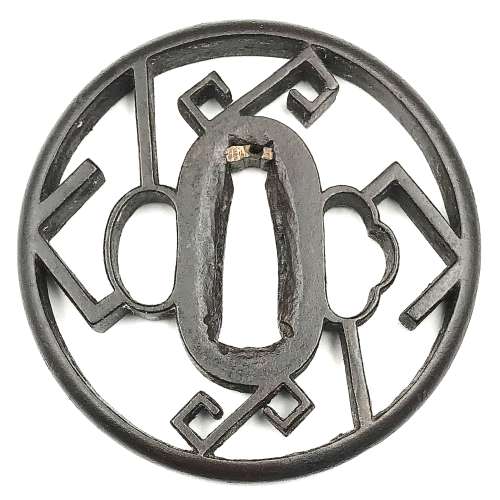
Iron tsuba of round form decorated with design of keys to the storehouse of the gods in openwork (sukashi). Rounded rim. Copper sekigane.
Unsigned. Early Edo period, 17th century.
Size: 71.0 x 70.9 x 6.0 mm.Merrily Baird, Symbols..: The Key to the Storehouse of the Gods, one of the Myriad Treasures.
-
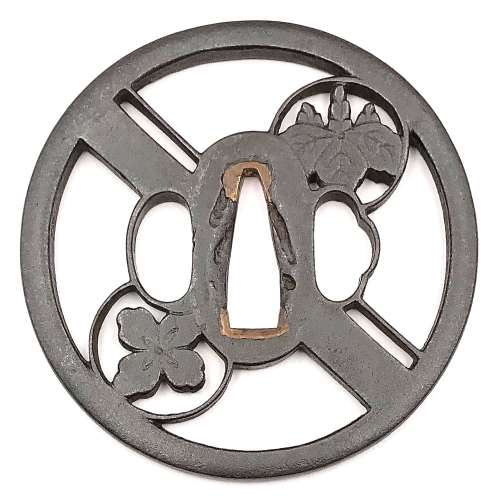 Iron tsuba of round form with design of double crossbar and two family crests (hikiryo-ni-kamon) in openwork (sukashi). Squared rim. Copper sekigane. Owari school. Early Edo period: Late 17th century (Kanbun / Enppo era). Height: 80.9 mm. Width: 80.8 mm. Rim thickness: 5.0 mm. Center thickness: 4.6 mm. Provenance: Sasano Masayuki Collection, № 172: "A paulownia and a clover are diagonally opposite two crossbars. This expressive design suggests a Higo origin, but the iron and the finish are certainly of the Owari school. Work of this nature may have been influenced by Hayashi Matashichi (1613-1699)."
Iron tsuba of round form with design of double crossbar and two family crests (hikiryo-ni-kamon) in openwork (sukashi). Squared rim. Copper sekigane. Owari school. Early Edo period: Late 17th century (Kanbun / Enppo era). Height: 80.9 mm. Width: 80.8 mm. Rim thickness: 5.0 mm. Center thickness: 4.6 mm. Provenance: Sasano Masayuki Collection, № 172: "A paulownia and a clover are diagonally opposite two crossbars. This expressive design suggests a Higo origin, but the iron and the finish are certainly of the Owari school. Work of this nature may have been influenced by Hayashi Matashichi (1613-1699)." -
 Iron tsuba of the round form (maru gata) with a grey patina pierced with the design of slanting rays of light (Jesuit’s IHS symbol) and a pair of ginger symbols [茗荷] (myōga) at top and bottom, in positive silhouette (ji-sukashi). This design is often called “tokei” [時計] or “clock gear”. Rounded rim, large hitsu-ana, copper fittings (sekigane). Unsigned, unpapered. Owari school. Early Edo period, early 17th century.
Iron tsuba of the round form (maru gata) with a grey patina pierced with the design of slanting rays of light (Jesuit’s IHS symbol) and a pair of ginger symbols [茗荷] (myōga) at top and bottom, in positive silhouette (ji-sukashi). This design is often called “tokei” [時計] or “clock gear”. Rounded rim, large hitsu-ana, copper fittings (sekigane). Unsigned, unpapered. Owari school. Early Edo period, early 17th century.Size: H 71.9 x W 71.1 x Th (centre) 5.5 cm.
For information regarding this type of tsuba see the article 'Kirishitan Ikenie Tsuba by Fred Geyer at Kokusai Tosogu Kai; The 2nd International Convention & Exhibition, October 18-23, 2006, pp. 84-91. 
IHS emblem of the Jesuits

茗荷 Myoga or Japanese ginger
-
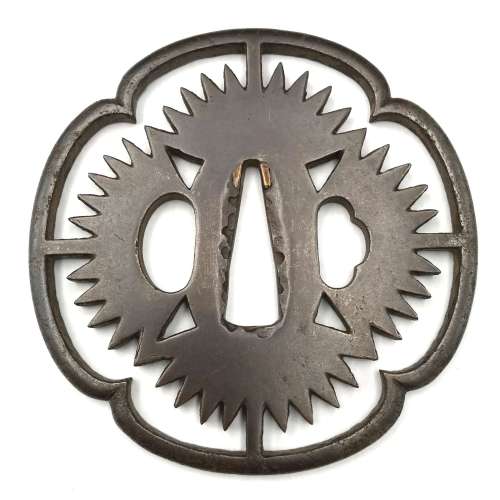 Iron tsuba of mokko form with slanting rays of light (shakoh) Christian motif (Jesuit's IHS symbol) in openwork (sukashi). Traditional description of this kind of design is called "tokei", or "clock gear". Owari school. Edo period.
Iron tsuba of mokko form with slanting rays of light (shakoh) Christian motif (Jesuit's IHS symbol) in openwork (sukashi). Traditional description of this kind of design is called "tokei", or "clock gear". Owari school. Edo period.Size: 83.4 x 83.1 x 4.4 mm
NTHK certified KANTEISHO ("Important Work"). In a custom wooden box. For information regarding shakoh tsuba see article 'Kirishitan Ikenie Tsuba by Fred Geyer at Kokusai Tosogu Kai; The 2nd International Convention & Exhibition, October 18-23, 2006, pp. 84-91. -
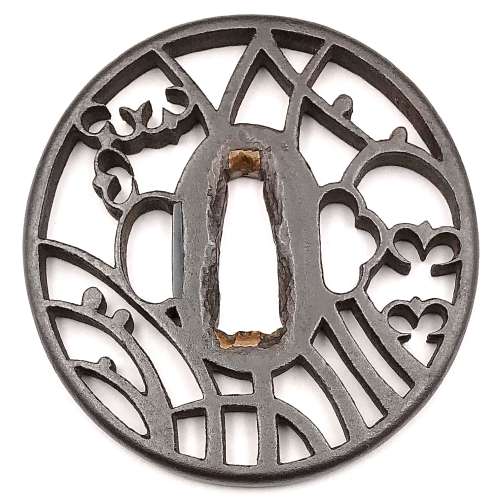 Iron tsuba of slightly elongated round form with design of wild geese and drops on pampas grass (masashino) in openwork (sukashi). Rounded rim. Copper sekigane. Owari school. Early Edo period: early 17th century (Kan-ei era). Height: 78.8 mm. Width: 76.3 mm. Rim thickness: 6.1 mm. Center thickness: 6.4 mm. Provenance: Sasano Masayuki Collection, № 169. A description of musashino symbolism can be found at Symbols of Japan by Merrily Baird [Merrily Baird. Symbols of Japan. Thematic motifs in art and design. Rizzoli international publications, Inc., 2001]: Musashino - "the plain of Musashi - a large expanse in the Tokyo area, was celebrated in poetry for the grasses that grew there before the recent era of industrialization... The use of Musashino themes was particularly common in the Momoyama and Edo periods". Pampas grass with dew drops and wild geese in flight collectively provide strong autumnal connotation.
Iron tsuba of slightly elongated round form with design of wild geese and drops on pampas grass (masashino) in openwork (sukashi). Rounded rim. Copper sekigane. Owari school. Early Edo period: early 17th century (Kan-ei era). Height: 78.8 mm. Width: 76.3 mm. Rim thickness: 6.1 mm. Center thickness: 6.4 mm. Provenance: Sasano Masayuki Collection, № 169. A description of musashino symbolism can be found at Symbols of Japan by Merrily Baird [Merrily Baird. Symbols of Japan. Thematic motifs in art and design. Rizzoli international publications, Inc., 2001]: Musashino - "the plain of Musashi - a large expanse in the Tokyo area, was celebrated in poetry for the grasses that grew there before the recent era of industrialization... The use of Musashino themes was particularly common in the Momoyama and Edo periods". Pampas grass with dew drops and wild geese in flight collectively provide strong autumnal connotation. -
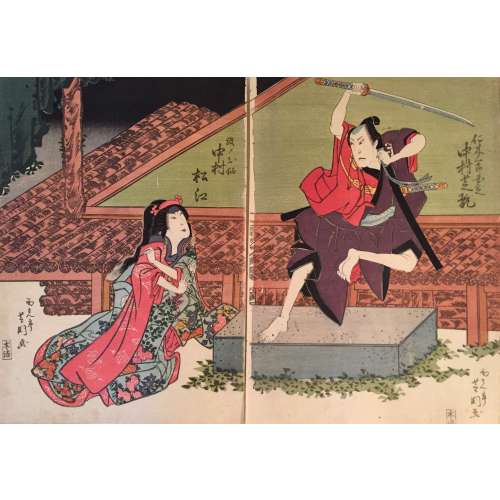 Saikotei Shibakuni (active 1821-1826). Osaka school. Play: Kinoshitakage Hazuma Gassen. Theatre: Nakamura-za /Naka-za (Osaka). Date: 7/1826. Horizontal oban diptych. SV: Nakamura Matsue III (Nakamura Tomijuro II) as female, Nakamura Utaemon III (Nakamura Shikan I) as a male. Publisher: Honya Seishichi [Marks 25-527 | 123f], Honsei, 1817-1838.
Saikotei Shibakuni (active 1821-1826). Osaka school. Play: Kinoshitakage Hazuma Gassen. Theatre: Nakamura-za /Naka-za (Osaka). Date: 7/1826. Horizontal oban diptych. SV: Nakamura Matsue III (Nakamura Tomijuro II) as female, Nakamura Utaemon III (Nakamura Shikan I) as a male. Publisher: Honya Seishichi [Marks 25-527 | 123f], Honsei, 1817-1838. -
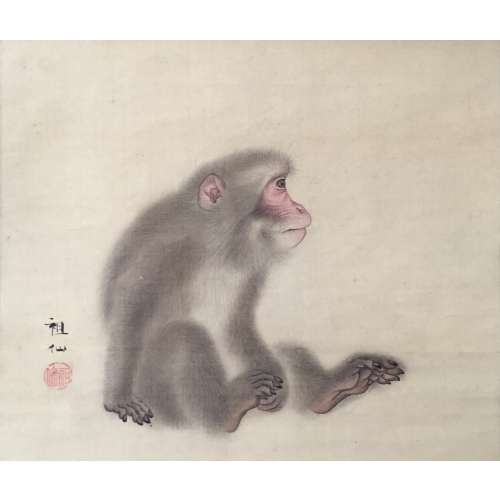 Mori Sosen (1747-1821). Seated Monkey. Hanging scroll painting. Ink and colour on silk. Signed: Sosen. Sealed: Sosen. 28.8 x 33.3 cm.
Mori Sosen (1747-1821). Seated Monkey. Hanging scroll painting. Ink and colour on silk. Signed: Sosen. Sealed: Sosen. 28.8 x 33.3 cm.


